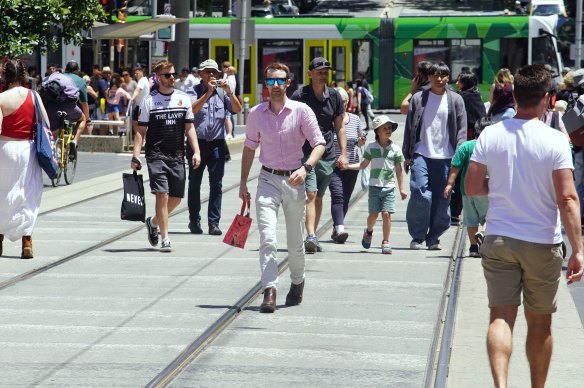This was published 1 year ago
Holiday spending is up, but Reserve Bank may trigger a ‘turning point’
By Jessica Yun
Retailers will be watching the Reserve Bank’s next move closely as cost-of-living pressures continue to cast a long shadow over consumer spending that some experts anticipate will drive a renewed enthusiasm for online shopping.
Australians are projected to spend $23.9 billion between Boxing Day to mid-January, according to predictions by the Australian Retailers Association (ARA) and Roy Morgan, which represents a 1.6 per cent uptick from the previous year as shoppers take advantage of bargains.

The Reserve Bank’s February decision on interest rates will be watched closely by retailers.Credit: Luis Enrique Ascui
But as the festive cheer fades, interest rates will remain a constraining factor on household budgets. The Reserve Bank will meet next month to decide whether to increase interest rates.
“There’s no question that the February RBA decision will be a turning point of some form or another,” said ARA chief industry affairs officer Fleur Brown.
“That will really set the tone around confidence for the year for business and consumers.”
The Reserve Bank lifted interest rates five times last year as high fuel prices, rising mortgages, rent and energy bills meant Australians traded down on purchases of groceries, alcohol, toys and clothing, which led to a boom in private-label and home-brand products and lower sales among department stores and luxury items.
“We’re not expecting much relief until towards the end of the year or even the start of 2025. It’s hard to be too predictive,” said Brown, noting that industrial action at container terminals in Melbourne, Sydney, Brisbane and Fremantle was contributing to “constipation” at the national ports.
“We’re hoping it will get resolved, but if it doesn’t, that could be a pain point this year for retail … We do expect that cost-of-living pressures will be a continued theme for much of 2024.”
Brown said retailers would also be waiting to see if the federal budget in May contains any measures like tax cuts to encourage consumer spending, or measures for the business sector to promote co-investment between government and industry in areas such as artificial intelligence or sustainability.
Prime Minister Anthony Albanese has signalled that providing cost-of-living relief to Australians is high on his agenda for 2024.

Amazon’s rapid growth in Australia has stolen online market share from players such as Kogan and Catch.Credit: Elke Meitzel
“We asked [the departments of Treasury and Finance] to give consideration to … the measures that can take pressure off families on cost of living without putting pressure on inflation,” Albanese said last Wednesday.
“That’s the key issue here: if you were just to distribute additional cash to people, you potentially make inflation worse and therefore don’t help to solve the problem.”
Retailers discounted earlier and more heavily during November, December and the start of January as Australians cashed in on their loyalty points and waited for deals to do their shopping.
Data from financial services agency Square showed a 29 per cent increase in transactions between Black Friday (November 24) and December 31 compared to the same period in 2022, as well as a similar increase at restaurant spending.
While Australians flocked to physical stores to do their shopping, they were also willing to make large purchases online, with the average digital purchase nearly four times bigger than the typical in-store spend.
E-commerce players and retailers are expected to perform well this year, with online sales growth far outstripping sales growth at bricks-and-mortar stores. Morningstar analyst Johannes Faul observed a structural return to e-commerce, which rocketed during the pandemic but dropped after lockdowns ended.
“As this structural shift marches on, retailers with greater online exposure should take market share,” Faul said in a recent industry pulse report.
“We expect online penetration of Australian retail sales to increase by around 0.5 per cent per year over the next decade. This would see e-commerce accounting for around 18 per cent of all retail sales by 2033, up from 13 per cent in fiscal 2023.”
Christmas and Boxing Day deals were twice as good in 2023 as the previous year, with Square data showing the average discount was 42 per cent, up from 21 per cent in 2022.
While some experts don’t believe retailers can sustain deep discounts and sacrifice their margins for much longer, Brown believes businesses will be responsive to the consumer.
“Retailers will do what they need to do to get through,” she said. “If Aussies are focused on a bargain, retailers will deliver that for them.”
The Business Briefing newsletter delivers major stories, exclusive coverage and expert opinion. Sign up to get it every weekday morning.